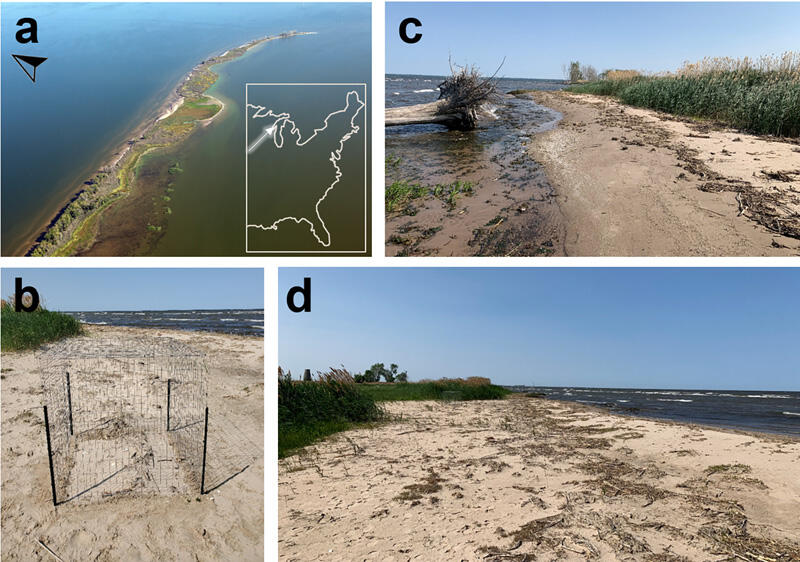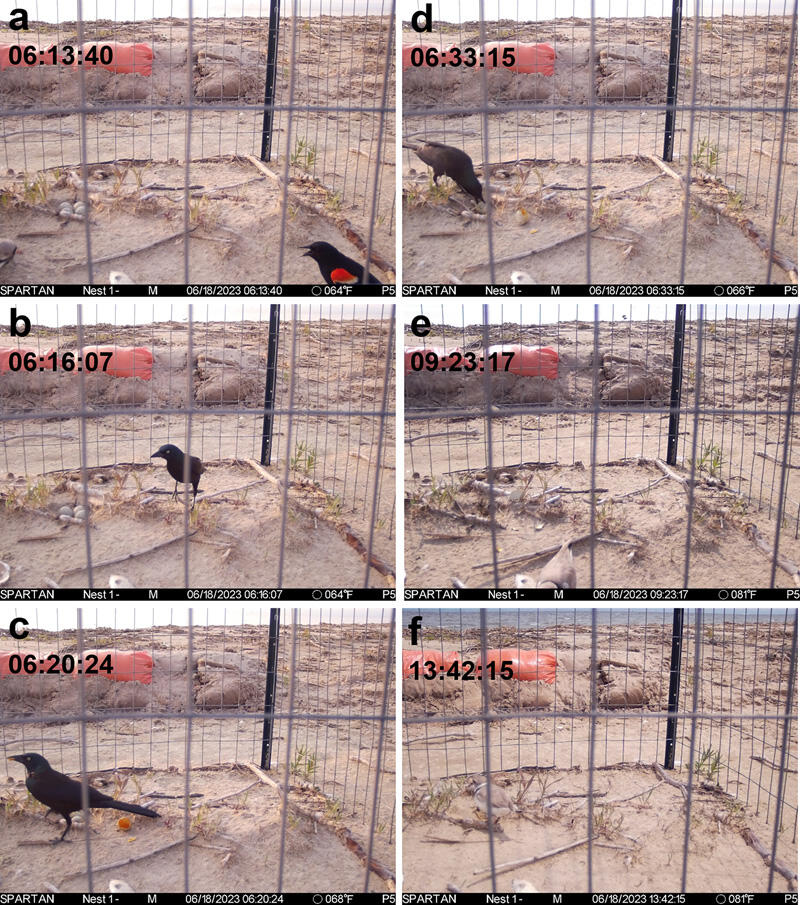CHICAGO, IL - (September 17, 2024) – A newly published study in Waterbirds: The International Journal of Waterbird Biology has revealed new evidence that Common Grackles (Quiscalus quiscula), an opportunistic foraging species that primarily consumes seeds and insects, will prey on the eggs of endangered Great Lakes Piping Plovers (Charadrius melodus). The study, led by Jade Arneson of U.S. Fish and Wildlife Service, Dennis Peloquin of U.S.D.A. Wildlife Services, Tom Prestby of Audubon Great Lakes, and Sarah Saunders of the National Audubon Society, provides the first photographic documentation of Common Grackles consuming Piping Plover eggs.
The study captured a series of trail camera images documenting a grackle consuming Piping Plover eggs from an exclosed (protected) nest at Longtail Point, Green Bay, Wisconsin, in June 2023. A predator exclosure is a large cage that surrounds and protects a nest and is designed to allow Piping Plovers to exit and enter freely, while preventing most larger animals from accessing the nest. This observation is of significant conservation concern as the Piping Plover population in the Great Lakes remains critically endangered with only 81 breeding pairs in 2024, while Common Grackles are a widespread migratory bird across the Great Lakes region.

“We were surprised to discover this behavior from Common Grackles,” said Dr. Sarah Saunders, Senior Manager of Quantitative Science at the National Audubon Society. “Trail cameras are used in conjunction with volunteers and staff to monitor and protect Great Lakes Piping Plover nests, but this is the first time this type of predation has been visually documented in any of the three breeding populations of Piping Plovers. It brings new challenges for protecting this vulnerable shorebird.”
Piping Plovers face a variety of threats that put their survival at risk. Habitat loss, human disturbance, and climate change are primary concerns, as these birds rely on relatively undisturbed sandy beaches for nesting. Predation by animals poses a significant threat to eggs and chicks and is managed in specific cases and at particular nesting sites.
Historically, predator management for Piping Plovers in the Great Lakes region has focused on larger species like American Crows, Herring Gulls, and mammals such as raccoons and foxes. The discovery of grackle predation adds complexity to these efforts, as current predator exclosures are not designed to keep out predators the size of grackles.

“Understanding and addressing this threat is critical to ensuring the survival of Piping Plovers in the Great Lakes,” said Tom Prestby, Wisconsin Conservation Manager at Audubon Great Lakes. “We recommend increased monitoring and potentially redesigning nest exclosures to prevent access by Common Grackles at sites that grackles inhabit.”
The paper also offers several key conservation recommendations, including identifying high-risk nesting locations frequented by grackles, controlling for scattered trees, shrubs, and herbaceous vegetation preferred by grackles, and/ or modifying or omitting exclosure use at these sites.
“Omitting exclosures may seem counterintuitive, but it is possible that through learned behavior grackles could begin to associate exclosures with a food reward - a Piping Plover nest and eggs,” says Jade Arneson, Biologist with the U.S. Fish and Wildlife Service. “Recognizing there are many trade-offs to use or non-use of exclosures, further study and observation of this behavior is needed; therefore, we recommend expanding the use of trail cameras to better understand the extent of grackle predation so we can adapt our conservation efforts accordingly.”
“While it is unlikely that Common Grackles will cause population-wide declines, every nest matters in the recovery of the Great Lakes Piping Plover,” Saunders added. “Our goal is to use this new information to improve protection strategies and give these birds the best chance to thrive.”
The study’s authors are part of the Great Lakes Piping Plover Recovery Team, which works to restore and maintain a viable plover breeding population across the Great Lakes through coordinated monitoring, protection and research. Being able to nest successfully and rear young safely to fledging is key to the species recovery effort. The Great Lakes Piping Plover population celebrated its third-consecutive record-breaking nesting season, with a total of 81 unique breeding pairs across the region this summer. The goal of the Great Lakes Piping Plover Recovery Team is to have a breeding population of at least 150 pairs for five consecutive years with at least 50 pairs occurring at breeding sites outside of the state of Michigan, the population’s stronghold. While there is still much work ahead, the population is trending in the right direction, and this study will inform the adaptation of on-the-ground strategies to protect the nests of these charismatic shorebirds.
Lower Green Bay Piping Plover monitoring is funded by the Great Lakes Restoration Initiative, which supports critical research and conservation efforts for the Piping Plover population across the region. Critical partners include the University of Minnesota banding and research team, Wisconsin Department of Natural Resources, U.S. Fish and Wildlife Services, United States Department of Agriculture and Audubon Great Lakes staff and volunteer monitors.
Contact: Nicole Minadeo, Communications Director, Audubon Great Lakes; Nicole.minadeo@audubon.org
About Audubon Great Lakes
Audubon Great Lakes is a regional office of Audubon, learn more at gl.audubon.org and follow us on Facebook, Twitter and Instagram.
The National Audubon Society protects birds and the places they need, today and tomorrow. Audubon works throughout the Americas using science, advocacy, education, and on-the-ground conservation. State programs, nature centers, chapters, and partners give Audubon an unparalleled wingspan that reaches millions of people each year to inform, inspire, and unite diverse communities in conservation action. A nonprofit conservation organization since 1905, Audubon believes in a world in which people and wildlife thrive.





